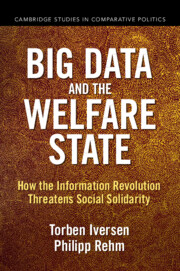Book contents
- Big Data and the Welfare State
- Cambridge Studies in Comparative Politics
- Big Data and the Welfare State
- Copyright page
- Dedication
- Contents
- Figures
- Tables
- Acknowledgments
- 1 Introduction
- 2 Theoretical Framework
- 3 A Brief Analytical History of Social Protection
- 4 Private Markets for Life and Health Insurance
- 5 Credit Markets
- 6 Labor Market Risks
- 7 Conclusion
- References
- Index
- Cambridge Studies in Comparative Politics
3 - A Brief Analytical History of Social Protection
Published online by Cambridge University Press: 25 May 2022
- Big Data and the Welfare State
- Cambridge Studies in Comparative Politics
- Big Data and the Welfare State
- Copyright page
- Dedication
- Contents
- Figures
- Tables
- Acknowledgments
- 1 Introduction
- 2 Theoretical Framework
- 3 A Brief Analytical History of Social Protection
- 4 Private Markets for Life and Health Insurance
- 5 Credit Markets
- 6 Labor Market Risks
- 7 Conclusion
- References
- Index
- Cambridge Studies in Comparative Politics
Summary
Chapter 3 offers a historical account of the emergence of the welfare state. In the absence of private or public insurance and faced with new, poorly understood, and existential risks, workers set up mutual aid societies (MASs) to cope with industrialization and urbanization. At their peak, MASs covered up to half of the (male) population but only protected against a small fraction of the risks of unemployment, disability, disease, old age, and death. While MASs tried to mitigate adverse selection and moral hazard through monitoring, they faced a double bind: they attracted bad risks while losing good risks to commercial insurance. Nor could they cope with correlated risks or support PAYG arrangements (the time-inconsistency problem). Ultimately, they were replaced by compulsory public social policy programs that mandated all citizens to join a common risk pool. The state had the power of compulsion, the ability to overcome the time-inconsistency problem, and majority support for social insurance in the absence of effective private alternatives. The result was a massively redistributive welfare state.
Keywords
- Type
- Chapter
- Information
- Big Data and the Welfare StateHow the Information Revolution Threatens Social Solidarity, pp. 44 - 69Publisher: Cambridge University PressPrint publication year: 2022

